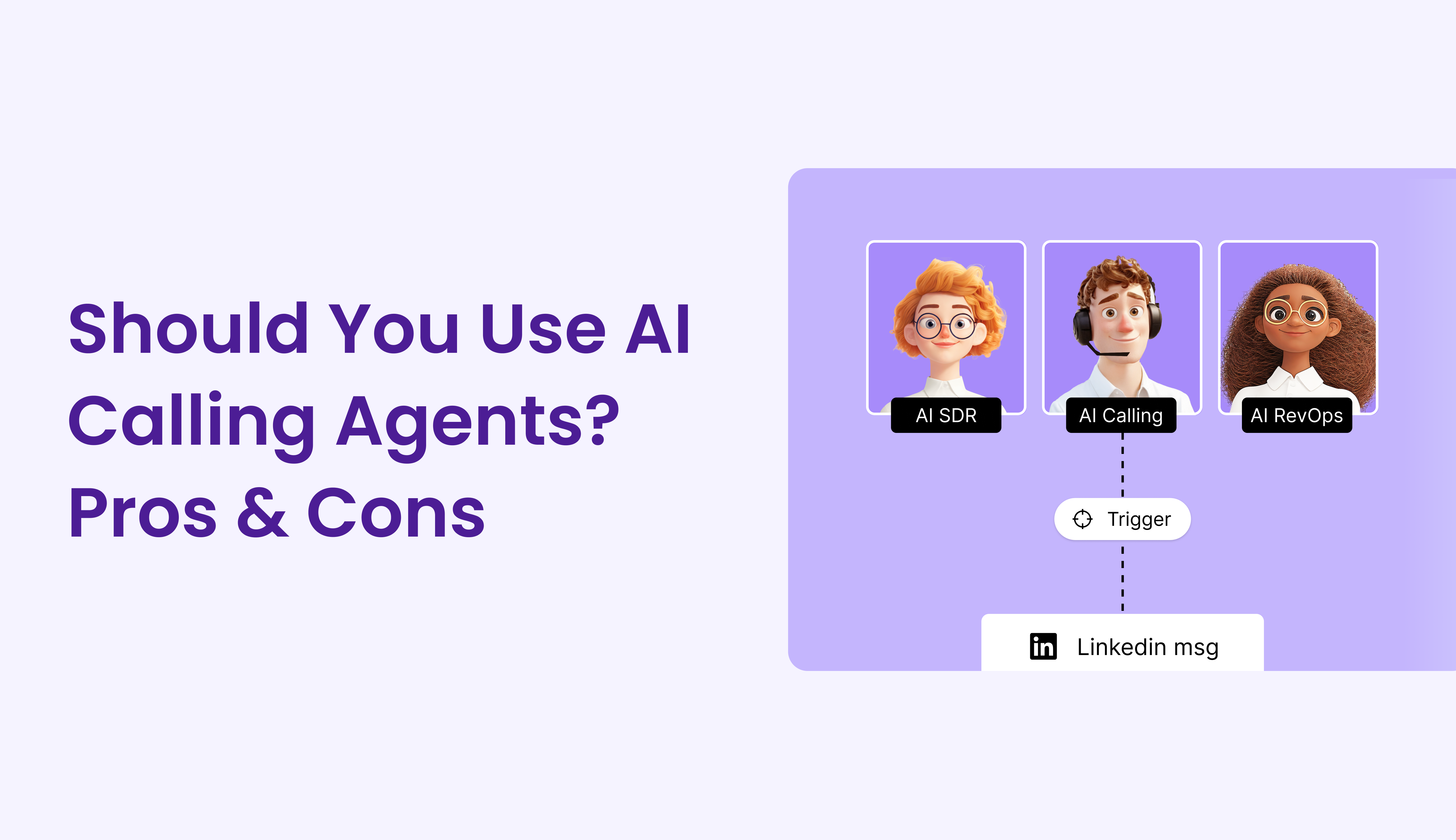
Should You Use AI Calling Agents? A Real-World Pros & Cons Breakdown
AI phone outreach has moved from experiment to execution. More GTM teams are now using AI calling agents for prospecting, qualification, reminders, and inbound handling - not because AI is trendy, but because buyers are harder to reach and humans alone don’t scale. This article takes a balanced look at AI calling: what it does well, where it fails, and how to apply it responsibly.
Why AI Calling Is Gaining Traction
Buyers don’t engage with cold, generic calls - they engage with relevant ones delivered at the right moment. At the same time, SDR teams are expensive to hire, train, and scale globally. AI calling agents can now speak naturally, adapt in real time, and use CRM context to tailor conversations. As a result, more companies are asking the same questions: “Should we use AI callers? What are the risks? How do we do this safely?”
The Pros: Where AI Calling Delivers Value
1) Scale & Availability
AI can call thousands of prospects across time zones without burnout or schedule limits.
2) Consistent Personalization
Scripts can adapt using CRM intel, past engagement, role, objection history, and intent.
3) Cost Efficiency
AI agents cost a fraction of building or outsourcing a large SDR function.
4) Real-Time Data Feedback
Transcripts, objections, sentiment, and call outcomes are logged automatically.
5) No Fatigue, No Bias
AI doesn’t get impatient, doesn’t prejudge leads, and doesn’t lose focus.
In Alta pilots, AI agents delivered 3× more completed dials and reduced time-to-first-touch by 40% versus manual outbound.
The Cons: Risks, Limits & Operational Realities
1) Risk of Sounding Robotic or Off-Intent
Even advanced AI can misread tone or nuance in key moments.
2) Compliance & Legal Constraints
Laws differ by region for consent, caller ID, recording, and DNC rules.
3) Complex Edge Cases
AI struggles with deep technical objections or high-stakes negotiation.
4) Model Maintenance
AI requires tuning, monitoring, and retraining — it is not “set and forget.”
5) Reputation Risk
A bad AI call can hurt trust if there is no human-first fallback.
6) Human Escalation Still Required
Enterprise cycles and mid-funnel deals still require human ownership.
How Alta Designs Around These Risks
Alta treats AI calling not as a replacement, but as a controlled, safe execution layer.
- Natural speech modeling (turn-taking, tone, hesitations, clarity)
- Human fallback when calls become complex or ambiguous
- Compliance embedded (opt-out flows, caller ID logic, region-aware rules)
- Adaptive micro-scripting instead of one rigid path
The goal isn’t perfect AI calls - it’s reliable, scalable calling with safeguards.
When AI Calling Makes Sense - And When It Doesn’t
Smart Use Cases
- Top-funnel qualification before AE involvement
- Reminder & follow-up calls post demo
- Inbound call handling & routing
- Re-engaging old pipeline or no-show leads
- High-volume, multi-region outbound motions
Avoid or Use With Caution
- Price or legal negotiation
- Enterprise strategic accounts
- Regulated or high-sensitivity industries
- Calls requiring deep product or technical depth
Best practice: AI opens, humans close.
AI calling works best when it handles the predictable, high-volume parts of the funnel and hands off the nuanced conversations to humans. Used this way, it doesn’t replace sales teams - it expands their reach and protects their time. The winning model isn’t AI instead of humans, but AI to open and humans to advance and close.
Frequently Asked Questions
Can AI callers replace SDRs completely?
No. AI callers are designed to take over the repetitive, high-volume parts of outbound dialing, qualifying, routing, logging, and following up. However they do not replace the human judgment, relationship-building, or negotiation skills needed in later stages of the sales cycle. The strongest teams use AI to open conversations and humans to advance and close them. In practice, AI doesn’t eliminate SDRs - it allows smaller teams to perform at the scale of much larger ones.
Does voice tone or accent matter in AI calls?
Yes tone, pacing, and accent have a direct impact on how prospects perceive credibility and intent. Voice that feels too robotic or mismatched to the buyer’s region can lead to immediate drop-off, even if the message is correct. Modern AI callers account for this by using natural speech modeling, localized accents, and adaptive tone profiles that adjust based on sentiment and context. The closer the AI sounds to a human delivering the right message for that audience, the higher the engagement.
How do I train an AI caller for my industry?
Training an AI caller starts with giving it the same context a skilled SDR would have objection logs, qualification rules, CRM data, ideal customer profiles, and examples of real calls from your team. The AI then uses that input to shape its decision paths, tone, and response logic. Over time, performance improves through continuous feedback loops: reviewing transcripts, tagging good vs. bad outcomes, and refining scripts based on what actually converts in your market. In short, you don’t train it once, you train it the way you train a team: iteratively, with real data.
What regulations should I be mindful of?
AI calling is regulated under the same frameworks that apply to human outbound calls, and the requirements differ by region. The main areas to watch are:
- Consent & Do-Not-Call rules (TCPA, DNC lists, GDPR marketing consent) - You must have legal grounds to call and honor opt-out requests.
- Caller identification laws - Many regions prohibit caller ID spoofing and require clear disclosure of who is calling.
- Call recording and data privacy - Some jurisdictions require one- or two-party consent to record, and restrict how transcripts and audio can be stored or used.
- Automated calling restrictions - Certain countries limit or ban fully automated outreach without explicit prior consent.
Any AI calling rollout should include built-in opt-out handling, region-aware compliance logic, and transparent caller identity to stay within legal and ethical boundaries.
How do I know if AI calling is right for my funnel?
AI calling is a strong fit when a large portion of your outbound motion is repetitive at the top of the funnel - things like qualification, follow-ups, reminders, and first-touch outreach. If 50–80% of your team’s calling time is spent on these tasks, AI typically delivers a positive ROI by increasing coverage without adding headcount. On the other hand, if most of your calls involve high-stakes negotiation or complex technical depth, a human-first approach may still be better. The simplest test: if the work is repeatable and rules-based, AI can likely do it well.

.png)





